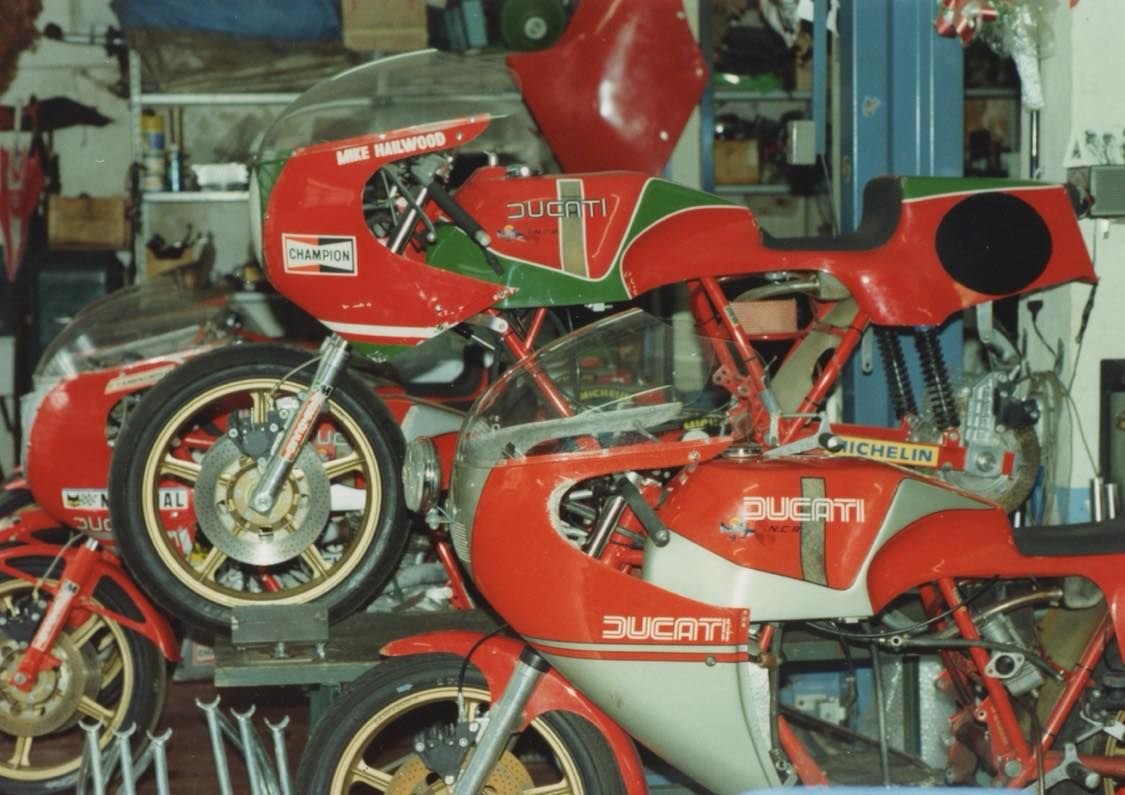
1978 DUCATI 900 NCR TT1
SOLD
An Ian Falloon History:
The History…
In 1967, factory mechanics Giorgio Nepoti, Rina Caracchi, and Rinaldo Rizzi set up a specialist race shop {NCR). After Rizzi left, NCR became Nepoti Caracchi Racing and they assisted in the preparation of the 1972 lmola machines. Located in via Signorini 16, close to the factory at Borgo Panigale, NCR's first official race entry was a 750 Super Sport in the 1973 lmola 200. Claudio Laigo finished 15th and eventually NCR became the unofficial factory racing team. After the success at Montjuich in 1973, Fabio Taglioni was determined to persevere with a racing program, even without the support of management, and teaming up with old friends seemed the obvious solution. Thus the moderately successful endurance racers of 1975 were entered under the NCR banner, although they were still prepared by Franco Farne, Mario Recchia and Piero Cavazzi, alongside Nepoti and Caracchi. With the increased endurance effort for 1976 the NCR machines became more specialized; they were pure works of art. Caracchi, the master of the lathe and milling machine, created beautiful components such as the rear brake caliper support. Nepoti, on the other hand, was responsible for the strength of the NCR, its crankshaft. With factory support they were able to create spectacular endurance racing machines, sharing virtually nothing with any production Ducati.
Photograph of side by side NCR TT1s
A week after the Isle of Man, Hailwood won at Mallory Park
The NCR workshop in 1978 and two new 900 NCRs prior to dispatch
Continued…
Even though Taglioni still wanted to compete in the Coupe d'Endurance, he knew that in this highly competitive category the Ducatis would never beat the might of Honda. So he greeted the advent of the Tourist Trophy Formula 1 race at the Isle of Man with relish. Created in 1976 to save the Isle of Man races following the boycott by leading Grand Prix riders in 1975, this was for production-based machinery. 1000 examples were required, and while the engine stroke must be retained there were few restrictions regarding engine and chassis modifications. The exhaust had to pass 115 dB(A) at 11 meters, but this was the same as endurance regulations. Taglioni reasoned he could almost run endurance specification machines in TT Fl, and the 900 would surely be competitive. Already in the 1976 production race at the Isle of Man, Roger Nichols and Steve Tonkin entered 860 cc 750 SS and gave some indication of the Ducati's suitability to the Island. Nichols set a best lap of 103.13 mph (165.96 km/h) before retiring. This result was good enough for Steve Wynne to persuade the factory to sell him a used 900 NCR endurance racer for the 1977 TTFl race. Nichols almost surpassed Phil Read on a Honda, however the race shortened a lap due to rain, allowing Read to win by 39 seconds. Much controversy ensued and many saw Nichols as the moral victor.
With the signing of Mike Hailwood for the 1978 Fl TT, Ducati decided to produce a small number of 900 NCR Formula One machines. Unlike the endurance racers, the Formula 1 900 NCR was a cataloged model, and according to Rino Caracchi eighteen complete machines were built, along with twenty spare engines. They carried 900 SS engine numbers but featured specially-cast crankcases incorporating a spin-on oil filter, and earlier versions retained the earlier 750 bevel-drive layout with points ignition. The displacement was the same as the production 900 SS at 864cc (86x74.4mm), also with an 80Q included valve angle. There were special 44 and 40mm nimonic valves, lighter 10:1 Borgo pistons, 12mm lift desmodromic camshafts, and a lightened crankshaft (7.4kg as opposed to 8kg without the alternator). The con-rods were the same 150mm length as the round-case 750 rather than the shorter squarecase rod, but with a 19mm gudgeon. The inlet ports were increased to 38mm, with the exhaust ports up to 34mm, while the bevel gears were shaved. The Fl 900 NCR also featured a close ratio six-dog gearbox, straight cut primary gears (31/75) with a dry clutch, and with Dell'Orto 40 mm carburettors produced 92 bhp at 8,500 rpm. To keep the 4kg of oil at 110QC the oil cooling system included a Citroen oil radiator with a crankshaft oil feed through the aluminum primary drive cover.
The most famous victory for the 900 NCR was Mike Hailwood’s win in the 1978 Isle of Man Formula TT
The Bike, #088989
Although quasi official factory racers NCR Ducatis carried engine and sometimes frame numbers from the regular Ducati 900 Super Sport production series. The 900 NCR TTl didn't have a frame number but all known examples had engine numbers. My research indicates that engines were built in two batches, one in 1977-1978 from around engine number 088238 to 088258 approximately and another from 088970 to 088990 approximately later in 1978. The endurance racers and TTl engines shared the same number sequence but fewer endurance motors were produced. These numbers also include spare engines. The motorcycle under examination here has an engine from the second series, indicating it was produced later in 1978 and wasn't one of the first batch of 900 NCR TTls. The number stamp is also identical to the factory stamping of the 1979 black and gold 900 Super Sport, of which production commenced in September 1978. Most of the known estimated 18-20 900 NCR TTls built have engine numbers in the first series, but at least five examples were produced in the second series, after the success in the Isle of Man Formula 1 TT in June 1978. This bike is definitely one of these and Murayama import records confirm that one 900 NCR was shipped to Japan in 1979.
In 1979 Mr. Timicio Ta mate of Osaka, Japan visited the Ducati factory in Bologna and ordered a 900 NCR with headlight and taillight. At this time he met the great Ducati engineer Fabio Taglioni and presented him with a copy of the Japanese motorcycle magazine Motorcyclist
“In my opinion this is an exceptional example of one of an estimated 18 Ducati 900 NCR TTl racing motorcycles produced from 1977 through 1980. Of these there are possibly only five or six remaining in original unraced condition, of which this is one. This motorcycle is also presented with a complete history and its provenance is unquestioned. The general presentation is also outstanding, with all the original parts present. This is a wonderful example of an extremely rare and desirable racing Ducati.”
- contributing editor and motorcycle historian/authenticator Ian Falloon
The Details
Although the 900 NCR engine carried production 900 engine numbers the crankcases were specially cast to include a narrow sump, spin-on oil filter and oil level sight glass. The clutch was dry and the cover incorporated an oil cooler take off. Underneath the sand cast primary drive cover was a set of lightened straight-cut primary gears
The 900 NCR engine was based in the 750 round-case but with special outer covers
Carburetors were Dell'Orto PHM40 as on the production 900 SS. These had open bell mouths, later rectangular float bowls, angled vents, tickler enrichers, and provision for a choke mount
Original seat padding still present and in excellent condition
1978 900 NCRs retained the round-case bevel covers
Precise fitted body fairings, details of clasp at joining section
The magnesium Campagnolo wheels on the 900 NCR had sizes of MT2.50x18 and MT3.00x18. The standard tires were racing PZ2 compound Michelin, an S41 3.50x18 on the front and TV4 4.00/5.60x18 on the rear. The manufacturing date was cast in the wheel, in this case 10/78
Instrumentation consists of the correct original white-faced Veglia tachometer.
The Daspa frame was constructed of 25CrMo4 and weighed only 12kg while the suspension was Marzocchi, the wheels magnesium Campagnolo, and the brakes Brembo with steel caliper pistons. The Marzocchi forks were also considerably narrower at 180mm (rather than the 195mm of the street bike). Nice touches included milled foot levers. The overall weight was only 160kg
Original fiberglass fairing, seen here from the interior showing the matting to the individual fibers
The rear shock absorber are Marzocchi AG oleo pneumatic 320mm. With 6.75mm springs - these provided a stroke of 90mm
Summary
In June 1978 the great motorcycle champion Mike Hailwood came out of retirement and rode a Ducati 900 NCR TT1 to victory in the TT F1 race at the Isle of Man. Hailwood was 38 years old and this victory was Ducati’s most significant since the Imola 200 in 1972. As TT F1 regulations required the racing bikes to be based on a production series, in 1978 Ducati engaged their quasi factory racing department NCR to build 25 900 TT1 machines. These were subsequently sold to well-heeled enthusiasts and racers, including Sports Motorcycles in Manchester who entered Hailwood in the TT. This NCR 900 was bought by Mr. Tamate in Japan in 1979 and subsequently went into Hideki Fujikami’s Collezione Giappone. It hasn’t been raced and is presented in as new condition, still with the original Michelin tires.
Additional Photographs:
1978 Ducati 900 NCR TT1
Photo of the 1978 Ducati 900 NCR TT1 going into the Moto Borgotaro shop
PHOTOS BY GLEN ALLSOP



